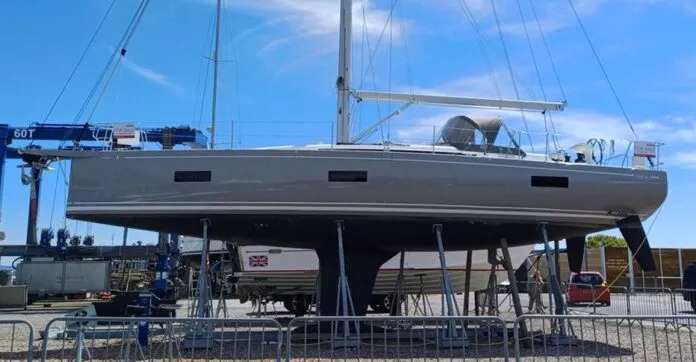
This is a simple explanation for those new to sailboats about what effect sailboat design has on performance. There are few “bad” boats but having a boat that is the wrong design for the type of sailing you want to do can, and does, put newcomers off the sport.
I think it is very common for people looking to buy a first boat to not have much understanding of how boats are designed. That’s not really surprising—yacht design is complex and it is natural to assume the designer knew what they were doing. The problem is that when creating a sailboat there are a number of competing factors. Do you want a boat that is fast, safe, sails well in all conditions, is roomy and easy to maintain? Probably all of those things but like most things in life you often can’t have it all!
Keel and rudder design is something that has changed radically over the last 50 odd years and has contributed to making boats faster. Editor-in-chief Tim Labute recently called attention to the risk of the keel falling off and that is a disaster. Fortunately, catastrophic failures in sailboats are rare. However, there is more to keel and rudder design than simply making sure they don’t fail. I’ll explain what the keel and rudder actually do and how they do. I am hoping this will help you understand why they come in so many sizes and shapes and why some old salts get passionate about it.
KEEL FUNCTIONS
The first function of the keel and the one most people know about is to keep the boat upright. Something between 35 percent and 50 percent of the boat’s weight is in the keel. The higher the percentage, the stiffer the boat. This translates into how much sail you can set in any given wind speed without the boat heeling too far. Basically, it works as a counterbalance. That is why the boat will immediately capsize if the keel is lost. So far so good but the keel does more than that.

WEIGHT AND LEEWAY
Think of the keel in two sections. The weight and the whatever attaches it to the boat, we will just call it a board, that connects that weight to the boat. In an ideal keel design, all the weight would be at the end where it has maximum effect in keeping the boat upright. That, of course, is not possible but keel bulbs or other shapes aim to get that weight as low as possible.
So now we have a weight on a board, does the board do anything? Absolutely! The shape of the board connecting the keel weight to the boat is far more than just a connecting rod and its size and shape has a massive influence on the way the boat sails. You have probably heard sails described as wings or aerofoils and know that the way the air flows around the sails drives the boat forward. That is only half the story. The keel is also there to stop the boat going sideways when the wind hits the sails, this is called leeway. To make it more complex, the keel can “fly” through the water generating lift just like the sails or be “stalled.” The keel is stalled when there is not enough water flowing past it to generate lift. The board or keel is just acting as a brake against drift when the boat is not moving forwards.
Look at the diagram below which shows a simplified keel:

ANGLE OF ATTACK
When the boat is moving, it never quite goes straight in the direction it is pointing. The difference between the heading (where the bow is pointing) and the course (the direction you are actually going in) means the keel has an “angle of attack.” When the water hits the keel at an angle, the keel works like an underwater sail and generates lift to windward. This is what stops the boat from just going sideways when the wind hits the sails.
The lift generated by the keel depends on its depth but also, very importantly, on the square of the water speed and the angle of attack. That means when you double the boat’s speed, the lift generated by the keel increases by four times. When that boat slows down, the force on the keel rapidly reduces. The lift from the keel still has to balance the force of the wind pushing on the sails so the angle of attack has to increase. In other words, you make more leeway. Eventually, as the boat slows further, the keel simply cannot produce enough lift and starts to simply slide sideways through the water. When this happens, we say the keel has “stalled.” With stalled keel the only thing stopping the boat moving sideways downwind is just the keel area.
LIFT
An important point when looking at keel design is also where the lift is generated. Most of the lift is created near the leading edge (the front of the keel). Making the keel wider does not generate a lot more lift but making it deeper does.

DRAG
The last thing we need to look at is drag. Moving anything through water creates drag. The more drag a boat has the more power it will need to go at any given speed. Drag is proportional to the underwater area and again the square of speed.
We can now see that having a narrow, deep keel will be the most efficient design, i.e. it will produce enough lift but less drag because it has a smaller area. But it needs the boat to be moving fast. As the boat slows down, it will stall easily and then create very little resistance to leeway compared to a wider shaped keel.
There is one more element to this. So far we have assumed the boat is making a steady course and the keel has a consistent angle of attack. That is never the case in real life! Changes in wind speed, heel angle and wave all knock the boat off course. When that happens, the boat will turn around the point marked A on the diagram. But point A is not the middle of the keel but always closer to the leading edge. This means the area behind point A is larger than the area in front of it. The result is that the water moving past the keel will try to push the boat back on course. This is illustrated below comparing a traditional long keel to a narrow fin.

From this, I think it is easy to see why a longer keel holds a course on its own without much work from the rudder. It is described as directionally stable or easy on the helm. Conversely, it takes more effort to make it turn so will less maneuverable when, for example, getting into a tight berth.
HOW KEEL SHAPE AFFECTS A BOAT’S PERFORMANCE
A short fin will generally mean a boat will go faster and need a smaller sail area. At anywhere close to hull speed, it will make minimal leeway and be highly maneuverable. The downside is that she will need more work on the helm or from an auto-pilot to keep on course and, if travelling at under half its max speed, she will make a lot of leeway. When “hove to” or “laying a hull” she will drift downwind readily or be knocked broadside to the sea and potentially rolled. If running before a big sea, she will be more prone to broach. In calm conditions she will be a great boat to sail but as conditions deteriorate, she will need a larger and more skilled crew to handle her. She will also not have the option to hove to in heavy weather but will probably have to run downwind and will broach easily when doing that. Generally, she will be a lively boat that will be great in sheltered waters and day sailing between marinas.

A longer keel, by contrast, will hold its course with little helm input and not be knocked off course by waves or wind changes. She will easily hove to and usually “lay a hull” pointing up to the wind. Therefore, in rough conditions, she will be much easier to handle or can be safely left to her own devices while the crew shelters below decks where it is warm, dry and safe! Overall, she will be more comfortable and easier for a small crew to handle. For this reason, she will be a great offshore boat. The downside is that she will need more sail area, possibly needing a bowsprit and a longer boom to overcome the greater drag. She will also probably not sail as close to the wind and generally be slower in lighter winds. She will also be less maneuverable under engine power when getting into a berth and may not reverse well. For day sailing in sheltered waters this may be more important than her sea keeping qualities.

A word to the wise. This article is aiming to give a very simplified explanation to help someone looking to buy their first cruising boat. Real yacht design is a lot more complex but someone looking to buy their first boat probably isn’t going to read a textbook before going to the boat show. They will, however, probably get advice that suggests opting for a substantial long fin and skeg from other sailors or that such a boat is old fashioned and will be “too slow” and difficult to maneuver so that they will be wetter with a modern short fin. Hopefully this will help people understand a bit more about what is behind that advice.





































Thanks for the great article, Roland. Very helpful in making a complex topic much more understandable. As someone looking to buy their first cruising boat (used), do you have any other suggested articles or books to read on how design affects performance?
Great article – next time could you plse include material on wing keel hydrodynamics ?
tx
Maybe I missed it. There was no mention of the effects of the fore and aft position/size of the keel, skeg, rudder etc has for a given sail plan on balancing the boat. (ie: ability to sail close-hauled with only a slight leeward rudder angle, thus minimizing drag.)